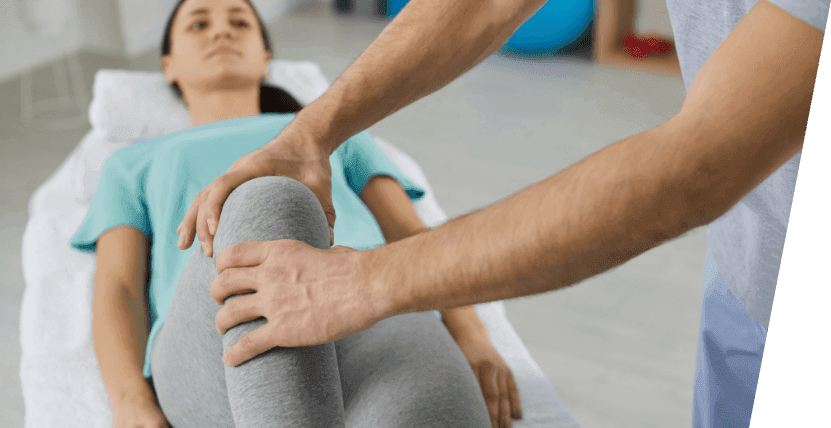
Date of posting: 27-02-2025
Reading time: 6 min read
The knee joint is one of the most complex joints in the human body. It plays a major role in facilitating movement and supports the body’s entire weight, due to which the risk of knee injuries and knee pain is exceedingly high. Because of the convolution of the knee joint structure and the fact that it is a weight-bearing joint, knee disorders are widespread, and the knee is one of the most vulnerable parts of the body that can get easily injured.
Knee pain is commonly caused by aging, injury, or recurrent stress on the knee. Cartilage tears, sprained or strained ligaments, arthritis, and tendinitis are common knee ailments.
Causes of Knee Pain: Minor knee injuries are commonly caused by stretching, twisting, and any activity that exceeds the knee’s endurance. Knee injuries can also be caused by sudden movements or jerks, which commonly occur while walking on uneven routes or when athletes train on rough surfaces.
Some injuries and diseases that can cause chronic knee pain are as follows:
Snapping and popping within the knee are frequent, but this should not be considered a symptom of any problem. Instead, it is a kind of knee injury that occurs when a ligament is torn. So, this is one problem that needs immediate attention as it can cause tremendous knee soreness for the victim. If left untreated for an extended period of time, it can result in permanent disability for the injured person.
Physiotherapy sessions for your knee There are many ways in which knee physiotherapy can help reduce pain and improve the condition of a knee injury.
Getting physiotherapy sessions for your knee can have a significant effect on reducing pain. Your therapist may help you with some exercises or massage techniques during a physiotherapy session or suggest a treatment plan.
The following is a list of how knee pain physiotherapy can benefit you:
Reduces Pain Endorphins are naturally released by the body to cope with pain or stress. Physiotherapy reduces any metabolic disturbances by relaxing the muscles and tendons around the knee, allowing them to relax. Furthermore, it relieves the pressure on the knee and allows for pain relief.
Improves Flexibility Regular physiotherapy will not only help with pain relief but will also improve knee mobility and leg flexibility.
Reduces Stiffness of Joints
Overuse or participation in strenuous physical activity will cause the knee muscles to stiffen. This will usually result in an injury, such as a sprain/strain or a ligament injury. Physiotherapy can help relieve this knee stiffness by relaxing the muscles and allowing the knee joints to rest.
Helps Strengthen and Rebuild Muscles
Lastly, knee physiotherapy will help rebuild the muscles around the joint. Knee muscles must be strong because they support the tendons, ligaments, and kneecap. Weak muscles result in less support, leading to further injury to the knee or foot. Physiotherapists perform gentle knee exercises to help the muscles soften and relax, allowing them to rebuild the damaged tissue. This will not only strengthen the knee but will also improve the condition of the initial injury.
Overall, physiotherapy is incredibly beneficial for knee injuries. Manipulation of muscles, tendons, and tissues allows the knee to release pressure as the muscles soften and relax. Physiotherapy can help with the rehabilitation of sudden, acute injuries like ligament damage or sprains. Additionally, injuries caused by overuse may benefit from a course of physiotherapy sessions to provide time for the knee to rest and recover and rebuild the strength of damaged muscles and ligaments.
Consult a physiotherapist When you are experiencing pain in your muscles or joints for more than 2-3 weeks or require assistance in rehabilitating from an injury, it is advisable to consult a physiotherapist for an assessment. While there is no specific period in which you should seek physiotherapy for knee pain, it is better to get an assessment and diagnosis as soon as possible.
How Painful is Physiotherapy Physiotherapy is not painful, but it is normal to have some short-term soreness after the treatment. Physiotherapists use modalities to reduce pain and increase healing before moving the affected joint, then progress to different exercises depending on the patient’s capability and strength. Physiotherapy should not be forceful to the point that the patient feels pain and uncomfortable because they might resist their movement, leading to more injuries.
Eliminate pain and recover faster at home with the help of the best physiotherapists. To get physiotherapy treatment for knee pain at home, contact our professional team for assessment and diagnosis.

Written by:
Apollo HomeCare is a trusted name in home healthcare, dedicated to delivering world-class medical care to patients in the comfort of their homes. With a team of expert doctors, nurses, and therapists, Apollo HomeCare provides personalized healthcare solutions, from post-surgical care and chronic disease management to physiotherapy and elder care. As a thought leader in the healthcare industry, Apollo HomeCare shares insightful blogs on home healthcare trends, wellness tips, and expert medical guidance to help individuals and families make informed health decisions. Our mission is to ensure quality healthcare is accessible, convenient, and compassionate.